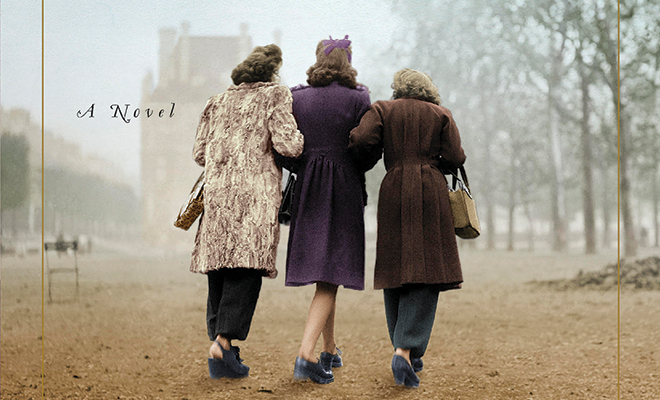
Lilac Girls by Martha Hall Kelly
Martha Hall Kelly is a native New Englander now living in Atlanta, Georgia. “I’m still pinching myself since Lilac Girls became a New York Times bestseller the week it was published in April 2016. I have been researching the story for over ten years and am excited beyond belief to finally share it with the world,” her website notes.
With her debut novel, Lilac’s Girls, Martha Hall Kelly joins the ranks of top storytellers Alice Hoffman, Jodi Picoult and Anita Shreve. Rich in characters, this book traces the lives of three women against the backdrop of World War II. Unlike most Holocaust literature, it follows American socialite Caroline Ferriday, Polish teenager Kasia Kuzmerick and a young German doctor, Herta Oberheuser, as their lives eventually intersect across the ocean and through the tumultuous times of war-torn Europe.
The story begins intriguingly with Caroline’s words, “If I’d known I was about to meet the man who’d shatter me like bone china on terra-cotta, I would have slept in.” From the beginning, the reader is treated to a narrative based on history. Descriptive prose details real-life characters whose every emotion is chronicled on the 476 pages. The author’s note at the end of the book unfolds how she meticulously reconstructed conversations from letters and other historical documents. Much dialogue is based on Caroline Ferriday’s surviving letters and from stories she wrote that are part of a collection at her childhood home in Connecticut.
In this page-turning novel, Caroline, former actress and socialite turned volunteer extraordinaire, encounters handsome French actor Paul Rodierre. Her world is turned upside down as she valiantly labors to help French orphans during the war while succumbing to her heart’s desire. Their relationship is a complicated affair because Paul is married to Rena, a Jewish woman. Throughout the book, Caroline continues to help both Paul and others trapped in the Nazi nightmare. In her elite social circle of the Vanderbilts and the Custers, she manages to fundraise and increase awareness for the plight of French citizens under Nazi rule.
Meanwhile, Polish teenager Kasia finds herself embroiled in underground resistance missions in an effort to gain the attention of Pietrik, a young man she adores. Her German-born mother, Halina, is a talented artist who deeply loves her husband and two daughters, Kasia and Zuzanna. Caught during one of her secret courier missions, Kasia unwittingly drags all three of them into the depths of despair. They are sent to Ravensbruck camp and subjected to medical trials along with other Polish women. This group of 74 prisoners is nicknamed the Rabbits because they serve as experimental subjects. She and her sister share all their thoughts, fears and hopes. Their close relationship is based on a composite of two real-life sisters who survived.
Across the border from Poland, Herta is determined to become a successful doctor despite the fact that female physicians have no real place in Hitler’s male-dominated Third Reich. Hailing from a poor family, she struggles financially and her medical school education is paid for with pieces of her own self-worth. She works long hours at a dermatology clinic but she’s bored with the cases. When searching the classified ads in The Journal of Medicine, Herta notices an ad for “a doctor needed at a reeducation camp for women, 90 km north of Berlin, near the resort town of Furstenberg on Lake Schwedt.” A change of scenery enticed her as did the fact that a former classmate worked there. Even the name sounded pleasant: Ravensbruck. At first Herta is repulsed by the government’s secret medical experiments doctors are conducting within the walls of this picturesque camp. She feels conflicted but chooses to stay on. Over time, she reconciles herself to the horrific work she and her colleagues undertake as part of the Nazi regime.
The writer paints a visceral portrait of life in the camps through both the physician’s and the prisoner’s eyes with these two strong female characters. There are always two sides to every story, and indeed this novel depicts both when Kasia’s mother, Halina, becomes Dr. Oberheuser’s right-hand assistant in the infirmary. A mystery ensues when a jealous co-worker reports Halina to the camp commandant and she disappears. Devastated, Kasia is unsure of what really happened and of Herta’s role in the whole sordid affair. Although she survives, Kasia continues to suffer from long-term side effects and depression from the horrific medical experiments. Years later, all three lives intersect, and the author does a seamless job of explaining the connections. The disappearance of her mother is finally resolved with an astonishing plot twist at the end of the book that will have the reader reaching for tissues while simultaneously cheering for Kasia.
Emotion-packed themes of love and justice combined with courageous actions complete this unusual account of this infamous crime against humanity. Told from a uniquely female perspective, it is a well-crafted novel of relationships and redemption. Thankfully, this new writer is already fast at work writing the prequel to Lilac Girls. ■







